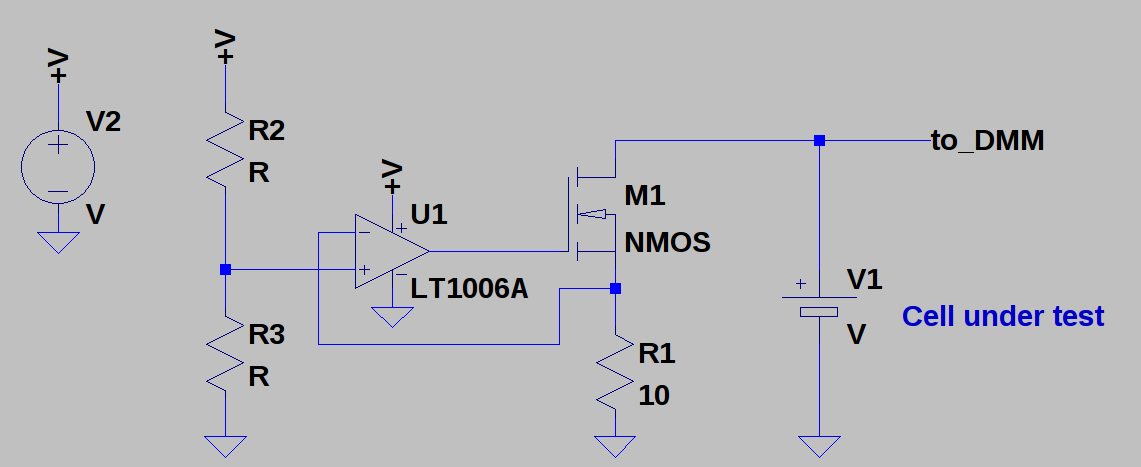I need to test some CRxxxx coin cells. So, I'm going to build a tester. Here's the rough idea.

The actual parts will depend on what I find first in the parts bins. The op amp maintains a constant discharge current from the cell through R1, while the cell voltage is monitored by a serial-port DMM. With this setup, I can measure the discharge characteristics of the cell at various current drains.
Why do I feel the need to do this? The amount of energy you can extract from a cell depends on the rate of discharge: faster discharge means less energy available. This is especially true for coin cells.
Jack Ganssle wrote an interesting article about his experiments with CR2032 cells on embedded.com a while back. I read it before when playing with TritiLEDs but quickly decided that his findings didn't apply to the really low current drain of those devices. I do agree with him that it's pointless to estimate run-times in excess of cell shelf life, though. (Shelf life for CRxxxx cells is generally taken to be 10 years.)
In any case, the article describes the problem with high-drain use of coin cells - the internal resistance increases quickly as capacity is used, and this resistance consumes more and more of the power as the cell ages. One data point from the article is that at a 30mA drain, you can only extract 39% of the energy from a CR2032 cell. This equates to a C/7.5 drain rate (225/30), which is very high.
I'm planning to use CR2477 cells, which have about 4.4x the capacity of CR2032s (1000 mAh vs 225 mAh). My initial thought was to discharge the cell (and charge the capacitors) at C/25 (25 hour rate), which for the CR2477 is 40mA. If we assume a CR2477 is just a 4.4x larger CR2032, then this would be equivalent to around a 9 mA drain on a CR2032. The article has curves from a 10 mA drain on a CR2032, which show that 88% of the energy can be extracted from a CR2032 at this rate before the cell voltage hits 2.0V. So, I roughly estimate that I can extract 88% of the energy from a CR2477 discharging it at a constant 40 mA.
What does it all mean? I might be OK with a 25-hour discharge/charge cycle. But, I think I should build a version of the circuit above and test some cells. I'll probably test some CR2032s initially, since they're so much cheaper than CR2477s (and I have a *lot* of CR2032s around for another project :-)
You may be wondering why I don't just charge the capacitors over a week (or more) to extract most of the energy from the cell. Other than having to wait for results (before the contest ends), the other problem is the self-discharge of the supercapacitors. The capacitors specify a maximum leakage of 1mA, which I'd like to keep to a small fraction of the charging current to maintain efficiency. There's probably a cross-over point where the extra capacity extracted from the cell is lost to capacitor leakage.
 Ted Yapo
Ted Yapo
Discussions
Become a Hackaday.io Member
Create an account to leave a comment. Already have an account? Log In.